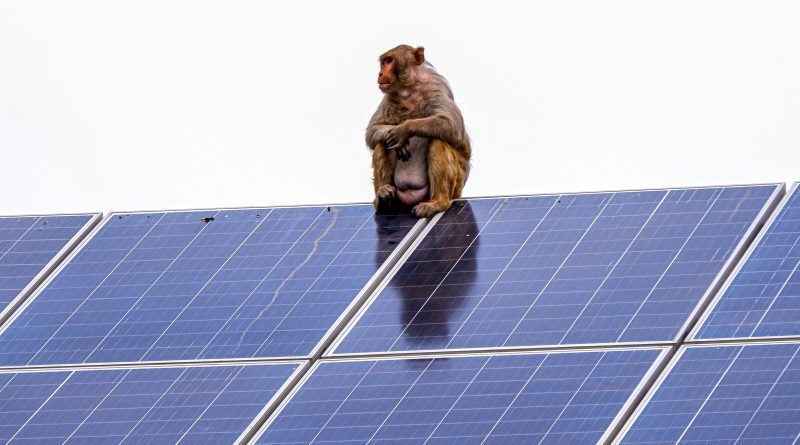Opinion: Unstoppable Renewable Energy, More Heat, and a New Resource

Photo: Rakshit Yadav c/o Unsplash.
Love, Justice and Climate Change

Even while the Trump administration is cancelling renewable energy projects and promoting coal and gas in the U.S., renewable energy is surging ahead globally. Renewable energy worldwide just passed a major landmark. In the first six months of 2025, the world’s solar and wind farms generated more electricity than coal plants for the first time in history.
For some years now, the world has been adding new renewable electricity generation, but the use of fossil fuel generated electricity has not gone down. This has been because the total global demand for electricity has grown even faster than new renewable energy was being installed. This year, for the first time, the growth in renewable electricity outpaced the growth of demand for electricity, leading to a small decline in the use of gas and coal. The growth in clean energy exceeding the growth of demand for electricity is another historic landmark.
China and India
China and India have led the world in this surging of solar and wind power. China added more renewable energy generation in the first half of the year than the rest of the world combined — adding so much that their use of fossil fuels dropped 2%. India added so much renewable electricity generation that their use of coal dropped 3% and their use of gas dropped 34%. By contrast, in the United States, the generation of electricity by coal grew 17% over the same period.
A report from the International Energy Agency (IEA) found that total renewable energy globally could more than double by the end of this decade, with solar power accounting for most of the increase. It found that China will lead the increase with India second. “In addition to growth in established markets, solar is set to surge in economies such as Saudi Arabia, Pakistan and several south-east Asian countries,” said the Director of the IEA.
Given the policies of the current federal government in the U.S., it is clear that China will lead the world in this revolution to renewable energy (both in its domestic installations and its exports to other nations), while the U.S. falls behind. This means that the U.S. will be missing out on installing comparable amounts of the clean electricity generation that is the least expensive, that reduces deadly air pollution, and slows global warming. The good news is that world clearly is not waiting for us.
Costs Dropping Precipitously
This revolution in clean energy generation has come about primarily because relatively modest subsidies for renewable energy got things moving and since then reductions in the cost of solar panels and wind turbines have been dramatic. Solar voltaic panels have dropped 90% in cost in the last decade and the cost of onshore wind turbines has fallen 70%. For years there was skepticism that solar and wind could ever supplant fossil fuels because the sun doesn’t shine at all hours and the wind doesn’t always blow. Now it turns out that massive batteries can solve that — they have already become major suppliers of power to utilities in California and increasingly throughout the world. The price of batteries has fallen 90% in the last decade, while their quality has improved at a similar rate.
Status Report – Dire Conditions
While much of the above is good news, we unfortunately need to also face the bad news, if we are to have an accurate picture of our situation. The good news above is very significant, but it is meager compared to the magnitude of ongoing greenhouse gas emissions and the acceleration of global warming. The Paris Agreement in 2015 called for a 43% reduction in greenhouse gas emissions by 2030. We are nowhere near meeting that target. In fact, globally, emissions have not fallen at all. In 2024 they again increased (by 0.8%).
Another report shows us how dire the situation is – landmarks of another kind. The State of Climate Action report from Systems Change Lab (with top experts from around the world) summarizes some of the current situation. The last 10 years have been the hottest on record, with 2024 the hottest. Ocean heat has reached record levels, with disastrous effects on corral reefs and marine life. Sea ice in the Arctic and in Antarctica has retreated to record lows. Warmer seas have produced more intense hurricanes. Unprecedented destructive forest fires and deadly heat and droughts have resulted in significant increases in atmospheric CO2. Deforestation has gotten worse, not better, in the last 10 years, with permanent forest loss at roughly 20 million acres per year.
Allies Everywhere
Fortunately, in virtually every nation of the world, there are passionate advocates for climate action and for preserving a livable environment on the earth. Clearly difficult times lie ahead, but if we each find some way to speak up and take action, we will have allies everywhere and much will be possible.
See how climate change is affecting where you live
Meanwhile, the folks at Climate Central have released a new tool for exploring how climate change is affecting your community. The Yale Climate Communications Project has called this tool “brilliant.” As they say, “If you live in the U.S., you can click on Explore your climate story, type in a big city near where you live (or your state), and instantly see information about how your corner of the world has changed. Depending on your location, the tool will tell you about impacts on rainfall, sea level rise, heat waves, crop stress, fall color, and more. You can also check on places where your friends and family live.
I looked up Western Massachusetts, where I live, and found the site put numbers to how much more rain, more heat, and more frequent extreme heat we have been experiencing. I also learned that in the last 20 years, Massachusetts has had 10 disasters from storms that each caused more than a billion dollars of damage.
Have a Conversation
See what it tells you about where you live and then compare that to where some friend or relative lives. This can be a great excuse/opportunity to contact them and have a conversation about climate change.
Russ Vernon-Jones was principal of Fort River School 1990-2008 and is currently a member of the Steering Committee of Climate Action Now-Western Massachusetts. He blogs regularly on climate justice at www.russvernonjones.org.

When I visited my daughter in Naples FL a month ago, I did not see a single solar panel on a house, in a yard or over a parking lot. One mega million dollar house in Port Royal was pointed out as having a solar roof that looked like black tile. And the AC is constant—so cold everywhere I need my fur coat..